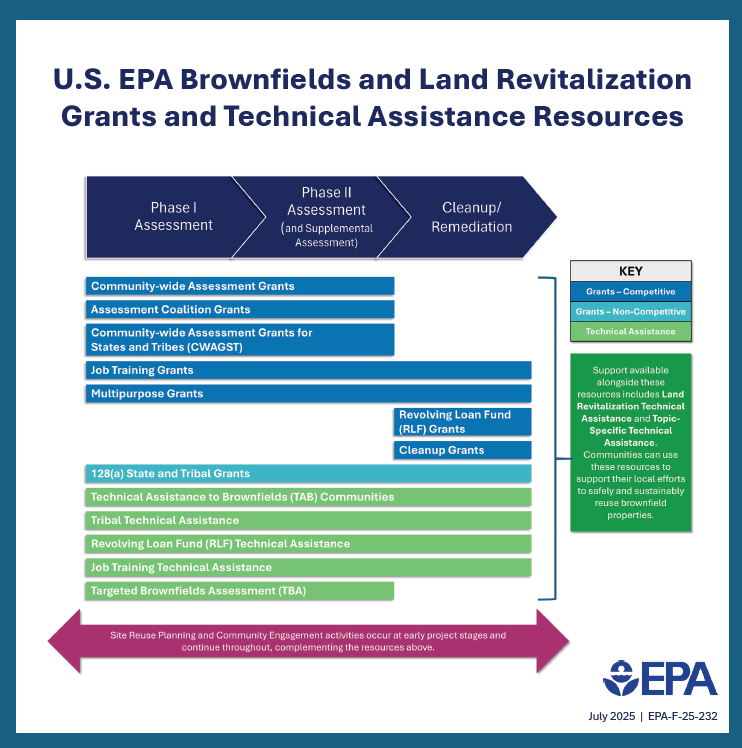About

EPA’s Brownfields Program brings unique technical and program management experience, as well as public and environmental health expertise, to individual brownfield communities. Our direct, ongoing involvement with communities encourages and strengthens local efforts to expand stakeholder engagement, convene partners, build capacity and plan for the safe reuse and redevelopment of brownfields to meet economic development and public health goals.
Our History
In the mid-1990s, EPA began providing seed money to local governments to launch hundreds of two-year pilot projects and developed guidance and tools for cleanup and redevelopment of brownfield sites. The 2002 Small Business Liability Relief and Brownfields Revitalization Act codified many of EPA's practices, policies and guidance. Read more about our program history, laws and regulations governing the way that communities may clean up and reuse contaminated properties and hear from the individuals who helped shape the program.
The 2018 Brownfields Utilization, Investment and Local Development (BUILD) Act reauthorized EPA’s Brownfields Program and approved changes that affect grants, ownership and liability provisions, and State and Tribal Response Programs.
Under the Infrastructure Investment and Jobs Act, Congress provided major funding to support planning, construction and operation of various public infrastructure improvements. These laws include new and existing federal programs that could be relevant and valuable for the brownfield and community revitalization projects. Explore how the program is using Infrastructure Investment and Jobs Act Funding.
Brownfields Now
Since then, EPA's Brownfields Program has continued to empower states and communities to work together to prevent, assess, safely clean up and sustainably reuse contaminated properties.
We invest in communities, removing barriers and providing seed money through grants and technical assistance. We offer training to build local capacity and support community leaders as they create partnerships to reuse sites.
We help local leaders transform brownfield sites into community assets with funds and technical assistance to overcome environmental, legal and fiscal challenges.
We are committed to helping communities revitalize brownfield properties, mitigate potential health risks and promote economic vitality.
We prepare job seekers for the brownfield labor market through the Brownfields Job Training Program, investing in organizations and people who live in communities with brownfield challenges and historical disinvestment. This program not only equips individuals with the necessary skills but also fosters a workforce ready to engage in the cleanup and redevelopment of these sites.
We support State and Tribal Response Programs to empower states, tribes, communities and other stakeholders to build strong partnerships and local capacity to prevent, assess, safely clean up and sustainably reuse brownfields in their jurisdictions.
We offer highly skilled staff who serve as EPA’s brownfield grant project officers, land revitalization coordinators and community development specialists.
In the United States, there are more than 450,000 brownfields.
Brownfields are properties that contain or may contain a hazardous substance, pollutant or contaminant, complicating efforts to expand, redevelop or reuse them. Cleaning up and reinvesting in these properties:
- Improves and protects the environment.
- Increases local tax bases.
- Facilitates job growth.
- Makes use of existing infrastructure.
- Takes development pressures off green spaces and working lands.
From Brownfields to Land Revitalization
A brownfield is a property where expansion, redevelopment or reuse may be complicated by the presence or potential presence of a hazardous substance, pollutant or contaminant.
Land revitalization refers to the process of returning the property to a safe and sustainable use after site assessment and cleanup.
EPA’s Brownfields Program supports land revitalization by providing grants and technical assistance to help communities clean up and sustainably reuse brownfield sites. The program distributes funds appropriated annually by Congress through competitive grants, non-competitive funding and technical assistance.
EPA’s Land Revitalization Program goes beyond site assessment and cleanup to support local community efforts to identify practical reuse options, remove barriers to site reuse, integrate sustainable and equitable approaches and attract resources. Land revitalization includes several different types of site reuse planning activities that can help communities understand local market conditions, financial feasibility and site design reuse scenarios. EPA’s Land Revitalization Toolkit contains a range of reuse-focused tools to help communities deal with their contaminated properties.
Brownfields and Land Revitalization Program Resources

Contact Us
Reach out with general questions or comments, or contact a brownfields representative in your EPA regional office.
Learn More
- 101.1 What are brownfields? (pptx) (82.91 MB)
- 101.2 How are communities affected? (pptx) (95.84 MB)
- 101.3 Reuse process overview (pptx) (82.69 MB)
- 101.4 Who can help? (pptx) (67.73 MB)
- 101.5 Using brownfields resources (pptx) (118.37 MB)
